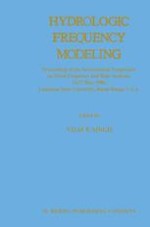1987 | OriginalPaper | Buchkapitel
Estimation of a Prior Distribution for the Bayesian Estimation of Pearson III Skews
verfasst von : Upmanu Lall
Erschienen in: Hydrologic Frequency Modeling
Verlag: Springer Netherlands
Enthalten in: Professional Book Archive
Aktivieren Sie unsere intelligente Suche, um passende Fachinhalte oder Patente zu finden.
Wählen Sie Textabschnitte aus um mit Künstlicher Intelligenz passenden Patente zu finden. powered by
Markieren Sie Textabschnitte, um KI-gestützt weitere passende Inhalte zu finden. powered by
The Pearson III distribution is often used as a model for the annual maximum streamflow process. Estimates of flood quantiles and the probabilities of exceedance of flood magnitudes, using this distribution and the small samples usually available are rather biased. A number of investigators have shown that the sampling distributions of, and the bias in the estimates of the Pearson III parameters, and consequently the flood quantiles and probabilities, are dependent only on the magnitude of the skew γ of the distribution and the sample size n. The importance of unbiased estimates of skew is thus recognized. The development of such unbiased estimators, using regional and/or site information, has met with limited success. This has contributed to the controversy surrounding the use of the Pearson III distribution to model the flood frequency Process.The usefulness of Bayesian estimation techniques in combining regional and site specific information has been recognized and stressed in the literature. One problem faced by the Bayesian estimator is the specification of an appropriate prior distribution to describe skews in a region of interest. The lack of this development has inhibited the use of Bayesian techniques. This paper presents a general framework for the estimation of a prior distribution for skews for a region where some data on annual maximum streamflows is available.Sampling distributions ϕ1n(g∣γ), for sample skew g estimated from a sample of size n, where the parent population skew γ is know, are available in the literature for a number of values of n and γ. Sampling distributions ϕ2n(g), for sample skew g estimated from a sample sixe n, using flood flow data from regional stations, where the parent population skew γ is unknown, can be derived for a bumber of sample sizes n, through resampling and subsampling techniques. The objective is then the determination of a prior distribution π(γ), that yields the observed sampling distributions ϕ2n(g), upon convolution with the sampling distributions ϕ1n(g∣γ), over some admissible set for γ, and for all sample sizes n. A discrete set of population skews γk (e.g. -6(0.5)6), is considered. The prior distribution π(γ) is then approximated as a set of probabilities pk associated with each of the admissible γk. The strategy for the minimum error estimation of π(γ) then entails the determination of π(γ) through the solution of a constrained least squares problem where the objective is to minimize the sum of square of errors in predicting the quantiles of the sampling distributions ϕ2n(g) through the convolution of π(γ) and quantiles of the sampling distributions ϕ2n(g∣γ), over all sample sizes n for which data is available.The prior probability distribution derived for regional skew can be used to develop unbiased Bayesian estimators of skew using site data. A framework is thus provided for the use of regional information in developing at site skew estimators. The framework can be extended to the estimation of flood quantiles and probabilities with uncertain skew. The techniques developed are applied to data from 314 U.S. gaging stations, that have no diversion or regulation of flow, and have at least 60 years of annual maximum data.
